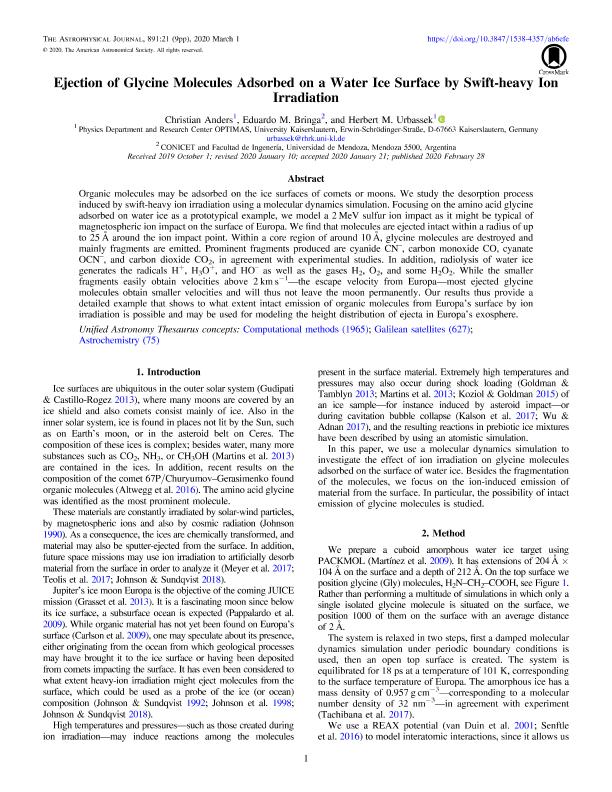Artículo
Ejection of Glycine Molecules Adsorbed on a Water Ice Surface by Swift-heavy Ion Irradiation
Fecha de publicación:
03/2020
Editorial:
IOP Publishing
Revista:
Astrophysical Journal
ISSN:
0004-637X
Idioma:
Inglés
Tipo de recurso:
Artículo publicado
Clasificación temática:
Resumen
Organic molecules may be adsorbed on the ice surfaces of comets or moons. We study the desorption process induced by swift-heavy ion irradiation using a molecular dynamics simulation. Focusing on the amino acid glycine adsorbed on water ice as a prototypical example, we model a 2 MeV sulfur ion impact as it might be typical of magnetospheric ion impact on the surface of Europa. We find that molecules are ejected intact within a radius of up to 25 Å around the ion impact point. Within a core region of around 10 Å, glycine molecules are destroyed and mainly fragments are emitted. Prominent fragments produced are cyanide CN-, carbon monoxide CO, cyanate OCN-, and carbon dioxide CO2, in agreement with experimental studies. In addition, radiolysis of water ice generates the radicals H+, H3O+, and HO- as well as the gases H2, O2, and some H2O2. While the smaller fragments easily obtain velocities above 2 km s-1 - the escape velocity from Europa - most ejected glycine molecules obtain smaller velocities and will thus not leave the moon permanently. Our results thus provide a detailed example that shows to what extent intact emission of organic molecules from Europa's surface by ion irradiation is possible and may be used for modeling the height distribution of ejecta in Europa's exosphere.
Palabras clave:
MOLECULAR DYNAMICS
,
GLYCINE
,
SPUTTERING
Archivos asociados
Licencia
Identificadores
Colecciones
Articulos(CCT - MENDOZA)
Articulos de CTRO.CIENTIFICO TECNOL.CONICET - MENDOZA
Articulos de CTRO.CIENTIFICO TECNOL.CONICET - MENDOZA
Citación
Anders, Christian; Bringa, Eduardo Marcial; Urbassek, Herbert M.; Ejection of Glycine Molecules Adsorbed on a Water Ice Surface by Swift-heavy Ion Irradiation; IOP Publishing; Astrophysical Journal; 891; 1; 3-2020; 1-9
Compartir
Altmétricas




